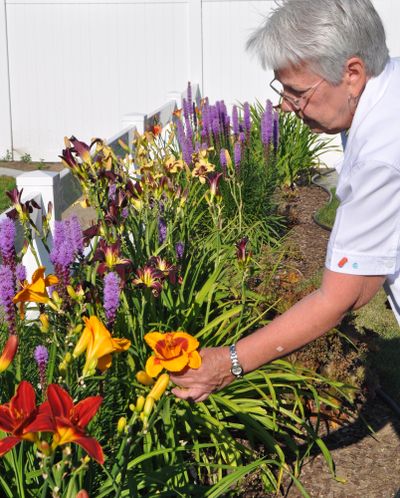Daylily blooms add bursts of color to many local gardens

This time of year, Fran Johnston is out in her garden just as the sun rises to greet the new crop of daylily blooms as they open. If she didn’t, she would miss the best of their color and shape. By evening, the flowers wilt and turn to mush.
Johnston owes her passion to her mother who loved “ditch lilies,” as wild daylilies used to be called. When they both lived in North Carolina, they would visit daylily growers and marvel at the colors and the myriad of cultivar names.
“I was fascinated by the cultivar names,” she said. “It never ceased to amaze me how they came up with so many new names to keep up with the new cultivars.
As her collection grew, she started selling plants to friends until it was just easier to open a business. She grew hundreds of cultivars that found their way into gardens across the country before she finally decided to really retire and move west to be closer to family.
“Spokane had four seasons and a really nice climate.”
They moved here in early December 2008, long past planting season, so Johnston shipped 60 of her favorite plants to a sister in Anacortes to hold over until she had a garden to plant them in. She now has several themed beds, including a biblical-themed entry garden.
While Johnston has a lot of experience growing daylilies, she is quick to say they are not hard to grow. “They are tough to kill.” Daylilies come in dozens of colors, as single and double blooms and with stripes, dots and other unusual shadings. “They still haven’t come up with a blue one though.” Depending on the cultivar, daylilies can bloom from mid-June into August.
Daylilies need sun to produce lots of flowers. Some cultivars don’t mind a little shade in the afternoon to keep their colors from fading. Most appreciate a light fertilization in the spring as growth begins. While they do best with regular watering, they are quite drought tolerant. They can also tolerate occasional soggy soils common in the spring.
Daylilies are normally marketed by their blooming characteristics and are readily available in nurseries and catalogs. Older, more common cultivars are usually not too expensive; new or unusual cultivars can fetch hundreds of dollars from the serious collectors. Often plants can be had free from a friend or neighbor’s garden when they need dividing.
The best time to divide daylilies is in the spring as growth begins but in reality they can be divided through the summer into early fall. A fan of leaves attached to a good-sized piece of root can be dug from around the edges of a larger plant any time before October. Replant the fan so the white line at the base of the leaves is at the soil surface.
One last thing: Daylily flowers are edible, some are sweeter than others but either way, just imagine the color they would bring to a salad.